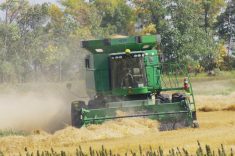Deciding what crops to plant this year will require lots of consideration of the various economic and political forces at play in the domestic and export grain trade, says Farm Credit Canada.
In its 2019 crop outlook, FCC cites many factors to think about before making final planting decisions. Chief among them are “China’s oversized influence on global oilseed markets, expansion opportunities for Canadian crops, rising input costs and a weaker Canadian dollar and higher interest rates.
“Profitability throughout Canada’s grains, oilseeds and pulses sectors will vary in 2019,” the report reads. “Production challenges, trade tensions and higher input costs generally dampen this outlook, while expanding potential in export markets and a lower Canadian dollar will support sector profits.”
Read Also

CUSMA access key among other trade noise: Seeds Canada panel
Seeds Canada conference panelists say Canada needs to stay focused and wait as U.S. trade and tariff chaos develops, and a Canada-U.S.-Mexico Agreement review looms
While there are decent prospects for wheat, corn and oilseeds, it said farmers should “seek efficiency gains by working to reduce the ratio of operating costs relative to revenues.
One example is the actual benefit of expenses to gain higher yields amid the uncertainty and economic uncertainty, it said.
“Proper evaluation of financial risks will be especially important on loans due for renewal in 2019, as periods of rising interest rates may require greater shares of revenues to cover interest payments. Watch your debt repayment capacity, given the slowdown in income – especially for operations with recent, significant investments.”
Farmers need to remember that the Pacific and European trade deals give them a leg up over many of their competitors, FCC said. “Canada’s preferential access to Asian markets and Europe foster opportunities for Canadian grains, oilseeds and pulses.”
Strong global demand for wheat and reduced competition from Australia, Russia and Ukraine should translate into a three per cent gain in Canadian wheat exports, FCC said. “Lower yields resulted in an estimated one per cent year-over-year increase in Canadian wheat production in 2018 despite an eight per cent increase in seeded area.
“The 2018 Canadian corn yield is expected, on average, to be the second highest on record. Prices should improve, despite unexpected global growth in production of 1.4 billion tons in 2018.”
Both soy and canola should see break-even to positive margins on the 2018-19 crop, FCC said. “A 4.7 per cent decline in 2018 production due to a difficult harvest and generally lower yields will support prices.
“A 13.5 per cent year-over-year reduction in overall 2018 acres and an average 8.7 per cent increase in yields combined to cut Canadian soybean production by 5.1 per cent to 7.3 million tonnes. Prices are expected to range between US$7.85 and US$9.35 in 2019 and exports to grow with support from a US$0.75 loonie.”
While a delayed 2018 harvest added to existing supplies of feed grain and lowered prices, “the demand for feed is projected to be strong, as North American livestock production responds to growing demand for animal proteins.”
Input costs will likely rise this year driven by higher labour costs and interest rates. Global fertilizer demand remains strong and prices could rise this year. Farm equipment prices are likely to remain elevated if U.S. steel tariffs are not removed but fuel costs should come down as supply and demand become balanced.
Long-range forecasts suggest an elevated probability of an El Niño event disrupting 2019 production with more rainfall in the southern part of the U.S. and drier conditions in the northern part of the U.S. and Canada. Drier conditions are expected to prevail as well in Asia and Africa.



















